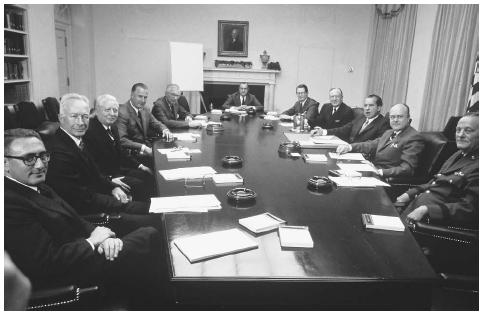Nixon Administration (1969–1974), United States National Security Policy
█ CARYN E. NEUMANN
Richard Nixon took office in 1969 as the country struggled to deal with the effects of the war in Vietnam. The inability of the United States to quickly win the war forced a review of national security policy. With the resulting Nixon Doctrine, the U.S. adjusted its foreign commitments to more effectively and efficiently utilize its resources. The Nixon administration pursued an honorable exit in Vietnam, sought peace with the Soviet Union, and reduced tensions with communist China by normalizing relations, while declining to pursue idealistic goals peripheral to the balance of military and geopolitical power.
The Nixon administration began with an overhaul of the national security advisory process. Nixon had apparently harbored resentments over perceived snubs delivered by Foreign Service officers when he served as vice-president under Eisenhower. He also preferred a solitary approach to decision-making. As president, he was determined to circumvent and minimize the State Department's traditional role in foreign policy in favor of conducting policy from the White House.
The National Security Council (NSC) under Nixon would function as a rival State Department with only adviser Henry Kissinger participating in the President's important discussions with visiting foreign officials. To further keep the State Department shut out of negotiations with foreign governments, Kissinger relied upon CIA communications for "back channel" messages as he traveled from country to country. The NSC also took control of the process of clearing key policy cables to overseas posts. Secretary of State William P. Rogers, less experienced in foreign affairs, played a minor role in policy formulation. In late 1973, Kissinger replaced Rogers. For the first time, one individual held simultaneously the positions of national security adviser and secretary of state.
The Vietnam War dominated American affairs in the late 1960s and it became the first major dilemma faced by the Nixon administration. To restore American power, Nixon decided to exit Southeast Asia in a way that would preserve the reputation of the U.S. as a country that honored its commitments. The administration elected to pursue a two-pronged approach of a phased withdrawal of ground troops and a modernization of the South Vietnamese military to enable it to assume full responsibility for the fighting. This policy stressed that an allied country must demonstrate the ability to provide for its own security since the U.S. would no longer provide the major defensive effort. The U.S. completed disengagement from Vietnam in 1973.

While the U.S. had been focused upon Vietnam, the Soviet Union had moved from a position of strategic inferiority to one of strategic parity. The system of mutual deterrence that rested upon the threat of retaliatory annihilation now no longer existed because the Soviets had developed a first-strike capability. Kissinger argued that the Soviets were more likely to be conciliatory if they feared that the U.S. would seek cordial relations with China. Since 1949, when the communists established control on mainland China, the U.S. had preferred to regard the exiled regime on Taiwan as the legitimate Chinese government. However, a Sino-American alliance would create a new balance of power by checking the Soviet superiority in conventional military forces. Accordingly, Nixon visited China in 1972 and drove a wedge between the two chief bastions of communism in the world. The Soviets, now anxious for an easing of tensions (known as détente) signed the Strategic Arms Limitation Talks agreement in May 1972 to limit the number of intercontinental ballistic missiles (ICBMs) and the construction of antiballistic missile systems (ABMs).
The Watergate scandal that forced Nixon's resignation in 1974 overshadowed his foreign policy accomplishments and contributed to a perceived mistrust of national leaders. Despite the enormous impact of Watergate, Nixon's pragmatic approach to international relations continues to influence debates about the proper role of the U.S. in world affairs.
█ FURTHER READING:
BOOKS:
Boll, Michael M. National Security Planning Roosevelt Through Reagan. Lexington: University Press of Kentucky, 1988.
Crabb, Cecil V., and Kevin V. Mulcahy. American National Security: A Presidential Perspective. Pacific Grove, CA: Brooks/Cole, 1991.
Record, Jeffrey. Making War, Thinking History: Munich, Vietnam, and Presidential Uses of Force from Korea to Kosovo. Annapolis, MD: Naval Institute Press, 2002.
ELECTRONIC:
White House. "History of the National Security Council, 1947–1997." < http://www.whitehouse.gov/nsc/history.html > (April 25, 2003).
SEE ALSO
CIA (United States Central Intelligence Agency)
Cold War (1950–1972)
Cold War (1972–1989): The Collapse of the Soviet Union
Department of State, United States
National Security Advisor, United States
National Security Strategy, United States
NSC (National Security Council)
NSC (National Security Council), History